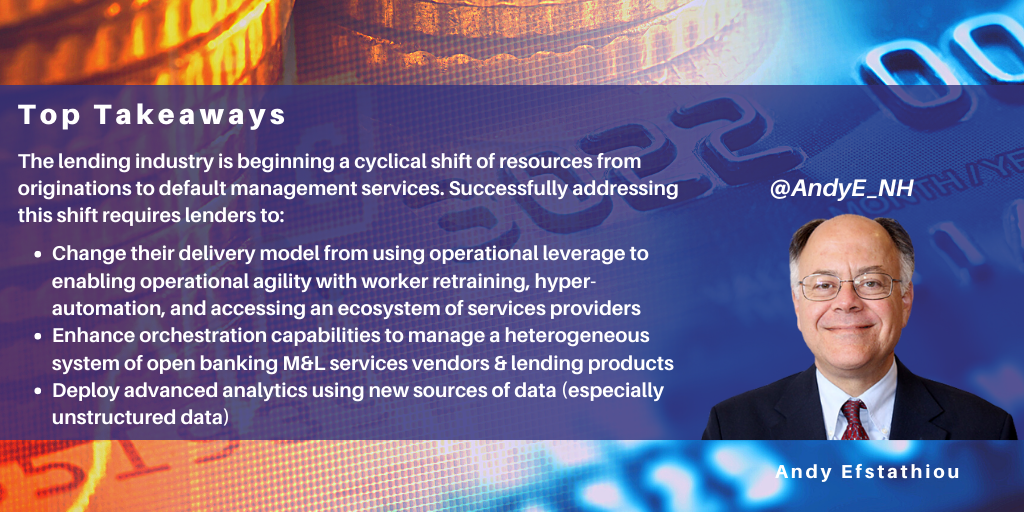posted on Oct 10, 2022 by Andy Efstathiou

In NelsonHall’s recently published market assessment, Transforming Mortgage and Loan Services, we found that lenders are changing their approach to mortgage and loan operations from a focus on BPS and integration services to a focus on cloud migration and data management services.
The goal for lending institutions today is to be able to support open ecosystem models, new product introductions, and process automation delivered for a wider range of lender types based on cloud-delivered operations. The pace of industry change is increasing, while the industry begins its cyclical shift from a focus on originations to default management services. The shift to cloud and digital-first delivery has expanded the scope of transformation projects as more processes are opened to third-party partners.
The state of digital operations in the lending industry
For the past year, lending institutions have been:
- Implementing intelligent automation to reduce manual processing and increase accuracy
- Migrating to a hybrid cloud to increase flexibility for new functionality and product time to market
- Building data lakes to coordinate data across silos without replacing their entire data structure
- Providing customers with self-service tools to reduce the cost of delivery and increase CSAT with faster resolutions.
Today, financial institutions anticipate an aggressive decline in originations and increase in lender defaults. This will necessitate downsizing originations and growing default management capabilities. To meet this market shift, over the next year, financial institutions will focus on:
- Increased use of consulting and combined ITS/BPS to identify a road map and convert CAPEX to OPEX
- Reskilling of origination workers to default processes to scale up default work
- Rearchitecting the lending platform to a microservices-based cloud-native application with an architecture that could integrate into their other platforms
- Testing and running open banking environments to start building an ecosystem of participants and a library of business models.
However, the external environment has put up barriers to transformation. The key barriers impeding the efforts of financial institutions include:
- Useful adoption of analytics: new sources of data (especially unstructured data) provide greater opportunities for the use of AI. However, only tier one lenders have access to large internal data pools. Smaller lenders must draw from industry-wide data pools. Smaller markets and product runs present similar issues: developing quality data for analysis remains difficult
- Access to emerging technology: all service vendors are building ecosystems for emerging technologies and acquiring staff skilled in relevant technologies. Finding the best new technologies and embedding them in effective platforms remains difficult
- New products and markets: lenders are rolling out new loan products rapidly, requiring a response from other lenders in order to remain relevant. The new products require high automation, omnichannel access, and high compliance capabilities
- Access to qualified staff: changing technologies change the required mix of staff skills, and distributed work environments (primarily WFH) limits knowledge transfer. Currently, cloud migration, AI, and default management skills are the least available capabilities.
Rising to the challenge
To address these challenges successfully, lending institutions need to focus on two activities: strategy and process execution.
Key factors in strategy include:
- Creating a roadmap to move operations to the cloud and match costs to revenues, as origination volumes decline and collections volumes grow
- Changing the operational model: M&L managers need to shift from operational leverage to leveraging agility (the ability to cost-effectively switch out workloads). This requires increased process discovery to identify processes for automation. The business model needs to support an open banking environment
- Building an ecosystem of operations vendors with domain knowledge and experience with clients’ operations environments, vendors with complementary digital skills to deliver services, and the ability to work within client operational practices and transfer knowledge.
Key factors in process execution include:
- In the short term, staff training to renovate skills for cyclical issues (i.e., default management) and technology (FinTech, cloud, and IA)
- Preferred services vendors should have the widest pool of Fintech solution providers supporting them
- Data management and orchestration drive accuracy, efficiency, and compliance. Lenders need to build COEs and libraries of successful RPA and data management use cases
- Transforming application development to a DevOps and low/no code model to speed the innovation cycle and migrate to cloud delivery
- Orchestration: selection and implementation of orchestration tools to manage a heterogeneous system of (open banking) M&L services vendors and lending products.
In summary, lending institutions are changing their goals from improving process efficiency for originations to increasing operational agility across sub-processes and ramping up collections capabilities. Margin pressure is too strong for lenders to achieve their business goals with just operational efficiency enhancements. Lenders need to change their business models (from closed platform/static product offerings to open platform/evolving product lines) to enable them to access best practice, best-cost services on-demand, to drive their operational performance.
